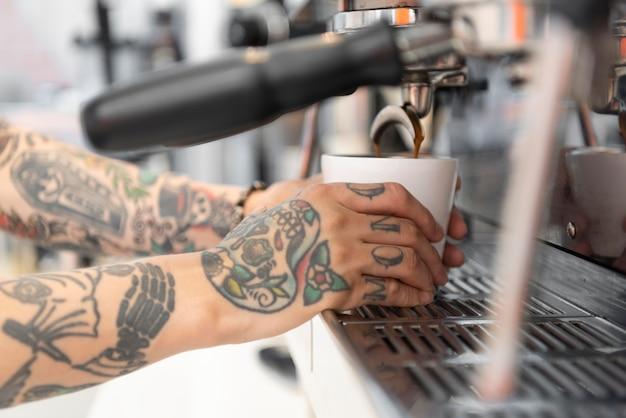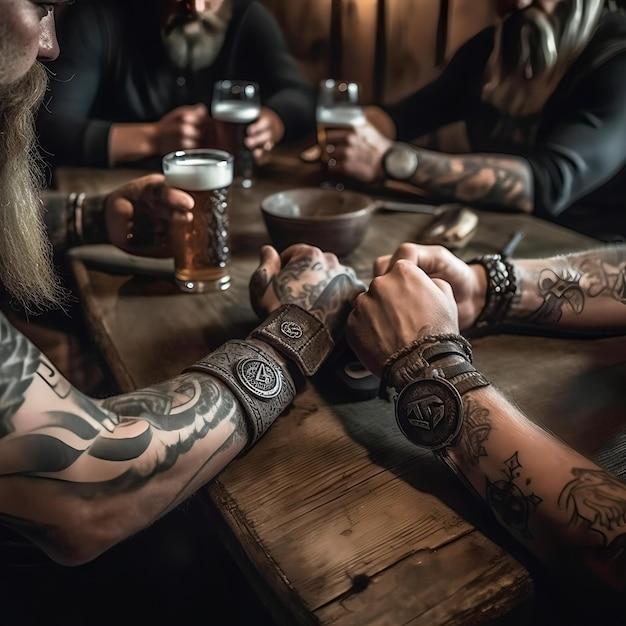The Last Supper, one of the most iconic moments in biblical history, has captivated artists and believers alike for centuries. This powerful scene, depicting Jesus and his disciples sharing a meal before his crucifixion, has become a popular choice for tattoos among those seeking to express their faith or appreciate its profound symbolism. In this blog post, we’ll delve into the origins of the Last Supper, explore the symbolism behind it, and uncover the meaning behind tattoos inspired by this historical event. Whether you’re curious about the location of the Last Supper, interested in the symbolism it represents, or considering a Last Supper tattoo yourself, read on to discover the captivating world of Last Supper tattoos.
Tattoos of The Last Supper
As tattoos continue to gain popularity and become more socially acceptable, the range of designs and themes people choose for their ink keeps expanding. One such intriguing and meaningful choice is the Last Supper tattoo. Depicting the iconic biblical scene where Jesus and his disciples came together for their final meal, this tattoo design holds deep spiritual significance for many. In this subsection, we’ll explore the symbolism and meaning behind tattoos of the Last Supper.
The Last Supper: A Symbol of Faith and Unity
The Last Supper tattoo serves as a visual representation of faith and unity. It’s a powerful reminder of the shared bond among Christians and the values of love, compassion, and forgiveness. This tattoo symbolizes the importance of breaking bread together, not only as a physical act of nourishment but also as a way to strengthen interpersonal relationships and forge spiritual connections.
The Artistic Interpretation
Tattoos of the Last Supper offer a canvas for artistic expression and stylistic creativity. With a wide variety of tattoo artists specializing in different techniques, you can choose the artistic interpretation that resonates with you. Some may opt for a realistic representation of the biblical scene, capturing the details of Jesus and the disciples around the table. Others may prefer a more abstract or symbolic approach, allowing for personal interpretation and individual meaning.
Tattoo Placement: An Expression of Personal Choice
When it comes to tattoo placement, the Last Supper offers a range of possibilities. Some people prefer a large-scale tattoo that covers their back or chest, allowing for intricate detailing and a grandiose display of symbolism. Others may choose a smaller, more discreet design that can be placed on their forearm, wrist, or ankle. The placement of this tattoo is a personal choice that can reflect your desired level of visibility and intimacy with the design.
The Last Supper Tattoo: Conversational Starter
Tattoos often serve as conversation starters, sparking dialogue and connections between people. A Last Supper tattoo is no exception. Its rich symbolism and religious connotations can inspire in-depth discussions about faith, spirituality, and the teachings of Jesus. Be prepared for thought-provoking conversations as others are likely to gravitate towards your tattoo, expressing curiosity and interest.
Wear Your Faith With Pride
If you’re considering a Last Supper tattoo, remember to embrace it with pride. This tattoo, like any other, is a personal choice and should be a reflection of your beliefs, values, and connection to your faith. Whether you’re expressing your unwavering devotion or simply appreciating the artistic beauty of the scene, a tattoo of the Last Supper is a powerful way to wear your faith on your sleeve, quite literally.
Now that you have a better understanding of the symbolism and meaning behind tattoos of the Last Supper, you can make an informed decision about this unique and thought-provoking design. Remember to choose an experienced tattoo artist who can bring your vision to life and create a lasting testament to your faith and spirituality.
Where Was the Last Supper
One of the most intriguing aspects of the Last Supper is the question of where it actually took place. While there are various theories and speculations, the exact location remains a topic of debate among historians and scholars. Let’s delve into the mystery and explore some popular theories on the whereabouts of this historical event.
The Upper Room in Jerusalem
According to the New Testament, the Last Supper took place in an Upper Room in Jerusalem. This room is often associated with the Cenacle, which means “dining room” in Latin. The Cenacle is traditionally believed to be the location where Jesus and his disciples gathered for their final meal together.
Scholars argue that the Upper Room was likely a private residence that belonged to one of Jesus’ followers. This theory is supported by the fact that Jesus had close relationships with a number of prominent individuals in Jerusalem, some of whom may have been able to provide such a space.
The Essene Quarter
Another theory suggests that the Last Supper was held in the Essene Quarter of Jerusalem. The Essenes were a Jewish sect known for their piety and strict observance of religious laws. Some believe that Jesus and his disciples shared the Passover meal in the home of an Essene member.
This theory is based on the idea that Jesus had connections with the Essene community and that their practices and teachings overlapped. While there is no concrete evidence to support this theory, it adds an interesting dimension to the story of the Last Supper.
Herod’s Palace
A more controversial theory posits that the Last Supper took place in the Herodian Palace rather than a private residence. This theory suggests that Jesus and his disciples may have been guests of Herod Antipas, the ruler of Galilee.
Supporters of this theory argue that Herod’s palace would have been an opulent and fitting setting for such a significant event. However, this theory is largely speculative and lacks concrete evidence.
The exact location of the Last Supper continues to be a subject of speculation and debate. While the Upper Room in Jerusalem is the most commonly accepted site, theories about the Essene Quarter or Herod’s Palace add interesting possibilities to the discussion.
Regardless of its exact location, the Last Supper remains a momentous event in religious history. Its significance extends beyond physical space, serving as a symbol of fellowship, sacrifice, and devotion.
Last Supper Tattoo Meaning
The Last Supper, with its iconic image of Jesus and his disciples, has intrigued and inspired people for centuries. It’s no wonder that many individuals choose to immortalize this significant moment in human history through tattoos. In this section, we’ll delve into the meaning behind Last Supper tattoos and explore why people are drawn to this meaningful and religious symbol.
Symbolizing Faith and Spirituality
One of the primary reasons people opt for Last Supper tattoos is to symbolize their faith and spirituality. The Last Supper is a pivotal event in Christian theology, representing the final meal Jesus had with his disciples before his crucifixion. By getting a Last Supper tattoo, individuals showcase their devotion to God and their belief in the teachings of Jesus Christ.
Commemorating Christian Values
Last Supper tattoos also serve as a way to commemorate and express Christian values. The scene depicted in the tattoo reinforces ideals of unity, sacrifice, love, and forgiveness – all of which were exemplified during this biblical event. These tattoos become a constant reminder of the values that guide believers in their daily lives and interactions with others.
Celebrating Artistic Appreciation
Beyond its religious significance, the Last Supper holds immense artistic value. Painted by the legendary Leonardo da Vinci, this masterpiece is renowned for its composition, symbolism, and attention to detail. People who choose to have a Last Supper tattoo often do so to pay homage to da Vinci’s artistic brilliance and to carry a piece of art history with them wherever they go.
Imagery and Symbolic Elements
When it comes to Last Supper tattoos, individuals have the freedom to personalize their designs by incorporating various imagery and symbolic elements. Some may choose to focus solely on Jesus and the disciples, while others may add elements such as crosses, doves, or biblical verses to enhance the tattoo’s meaning. Each addition carries its own significance and allows the tattoo to reflect the wearer’s unique interpretation of the Last Supper.
A Testament to Personal Beliefs
Last Supper tattoos can be seen as a personal testament to one’s beliefs, serving as a conversation starter and an opportunity to share one’s faith. These tattoos often spark curiosity and intrigue, opening doors for meaningful conversations about Christianity and its teachings. They can also serve as a source of strength and comfort during times of doubt or challenge, reminding individuals of their convictions and providing a sense of solace and support.
In conclusion, Last Supper tattoos are not merely decorative ink on the skin; they hold deep spiritual and personal significance. Whether as a symbol of faith, a celebration of Christian values, an appreciation of art, or a testament to personal beliefs, these tattoos serve as powerful reminders of the enduring impact of the Last Supper and its teachings.
What is the Symbolism of the Last Supper
The Last Supper is one of the most iconic religious events in history, depicting Jesus Christ sharing a final meal with his disciples before his crucifixion. But beyond its historical significance, this event is rich in symbolism that holds profound meaning for believers. Let’s take a closer look at the symbolism of the Last Supper and unravel its spiritual depth.
The Table: A Fellowship of Equals
At the heart of the Last Supper lies a table, around which Jesus and his twelve disciples gather. This simple table represents the idea of fellowship and equality. Regardless of their individual backgrounds or status, all the disciples are invited to share the meal and partake in the spiritual nourishment offered by Jesus. Through this symbolism, the Last Supper teaches us that no matter who we are or where we come from, we are all equal in the eyes of God.
The Bread and Wine: Sacrifice and Salvation
During the Last Supper, Jesus breaks bread and shares wine with his disciples, referring to them as his body and blood. This act symbolizes the concept of sacrifice and salvation. Just as Jesus offers his body and blood for the redemption of humanity, the bread and wine represent the eternal sustenance and forgiveness offered by his sacrifice. Through the symbolism of the bread and wine, the Last Supper reminds us of the profound love and grace that form the foundation of the Christian faith.
The Apostles: Faith and Fallibility
The disciples seated around the table in Leonardo da Vinci’s famous painting of the Last Supper represent more than just Jesus’ closest followers. Each apostle embodies different human qualities and serves as a reminder of the complexities of faith and fallibility. From faithful Peter to doubting Thomas, the apostles represent the diverse range of emotions and struggles that followers of Christ experience. Their presence at the table symbolizes the imperfect yet ever-relevant nature of humanity’s relationship with spirituality.
Judas Iscariot: Betrayal and Redemption
One of the most poignant and controversial aspects of the Last Supper is the figure of Judas Iscariot, who ultimately betrays Jesus. While his actions bring about Jesus’ crucifixion, Judas also plays a significant role in the grand narrative of redemption. His presence at the table serves as a reminder that even in our darkest moments, redemption and forgiveness are still possible. Judas stands as a symbol of the human capacity for both sin and the potential for salvation.
The Last Supper, with all its symbolism, encapsulates the essence of the Christian faith. It teaches us about the unity of believers, the transformative power of sacrifice, the complexities of faith, and the possibilities of redemption. As we dive into the rich meanings behind this historic event, we gain a deeper understanding not only of the Last Supper itself but also of the profound spiritual truths it represents.



